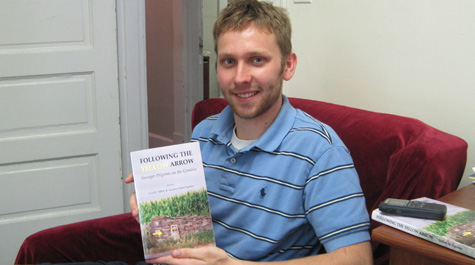W&M student, mother collaborate on Camino de Santiago book
Andrew Talbot Squires ’11 has walked the Camino de Santiago three times, twice with his mother, who also has taken several classes of her students from Roanoke College on the famed 500-mile pilgrimage. Those experiences, and hearing about hundreds of students from other colleges and universities who had made the trip, convinced Squires that there surely had to be a book or two chronicling the experiences and reflections of fellow students and young adults.
He searched and found . . . nothing.
“There were lots of books, movies, conferences, but they were all geared to older people, especially retirees,” Squires said. “It seemed like they were the driving force behind it.”
Squires and his mother, Lynn Talbot, a Spanish professor, decided it was time to do something about it.
The result is “Following the Yellow Arrow: Younger Pilgrims on the Camino” (WingSpan Press), which was released about two months ago. It is a collection of 21 essays – two written by Andrew, one each by W&M alums Daniel Hieber and Ryan Jackson – compiled and edited by mother and son.
“Some from Roanoke College, some I personally knew had hiked and asked, some of them (W&M professor) George Greenia was very good about getting,” Squires said. “He’d put the word out that a fellow Camino colleague was looking to (put together a collection of essays) and he’d call a fellow professor and say, ‘You’re at Michigan, can you get your students to do it?’ The network just branched.”
Although its popularity has exploded inn recent years, many people still have never heard of the Camino de Santiago. Translated to “The Way of St. James,” the Camino is a large network of ancient pilgrim routes stretching across Europe and coming together at the tomb of St. James in Santiago de Compostela in northwest Spain. During the middle ages, people walked out of their front doors and started off to Santiago, which was how the network developed.
Some people set out on the Camino for spiritual reasons; others find spiritual reasons along the way as they meet other pilgrims, attend pilgrim masses in churches and monasteries and cathedrals, and see the large infrastructure of buildings provided for pilgrims over many centuries.
“Following the Yellow Arrow” is a rich tapestry of stories touching on traditional Camino themes:
• Allison, an anorexic, bi-polar young woman fractures her foot one week into the journey but keeps going. She discovers that one may start the walk alone, but you rarely finish it that way.
• Drew answers questions about his shell tattoo by telling the story of his Camino walk in summer 2006.
• Ryan surreptitiously carries a buddy’s Bible in his backpack so that his struggling friend won’t have to relinquish a cherished gift from his mother.
• Phillip at age 15 walks the Camino with his grandfather, 60 years his senior, and forges a lasting family connection.
“We reprinted everything,” Squires said. “People would send us six or seven pages (hand) written and we were saying. ‘We’d like it to be a little longer, a little more depth. Can you do that?’ There was a lot of feedback back and forth with the authors.”
A year later, they had a book, filtered through the pipeline of self-publishing.
“Both of my parents are professors and they’ve been through the full dress of getting a publisher,” Squires said. “We didn’t want, since it’s a niche publication, a publisher accepting it then coming and saying ‘The price is going to be $45.’ This way it’s on Amazon for about $13.”
Not surprisingly, Squires says there is a vast difference in how people view the Camino experience, depending on their age.
“A lot of older people write after a major event in their lives: divorce, loss of a child, a change of careers, medical issues, the death of someone close. I think when (older) people walk the Camino, they do it in the perspective of their past life or how this event has changed them.
“With youth, it’s much more exploratory. We’re headed forward in the world rather than looking back. In that sense, the Camino is about experiencing new things, not about looking back.”

















